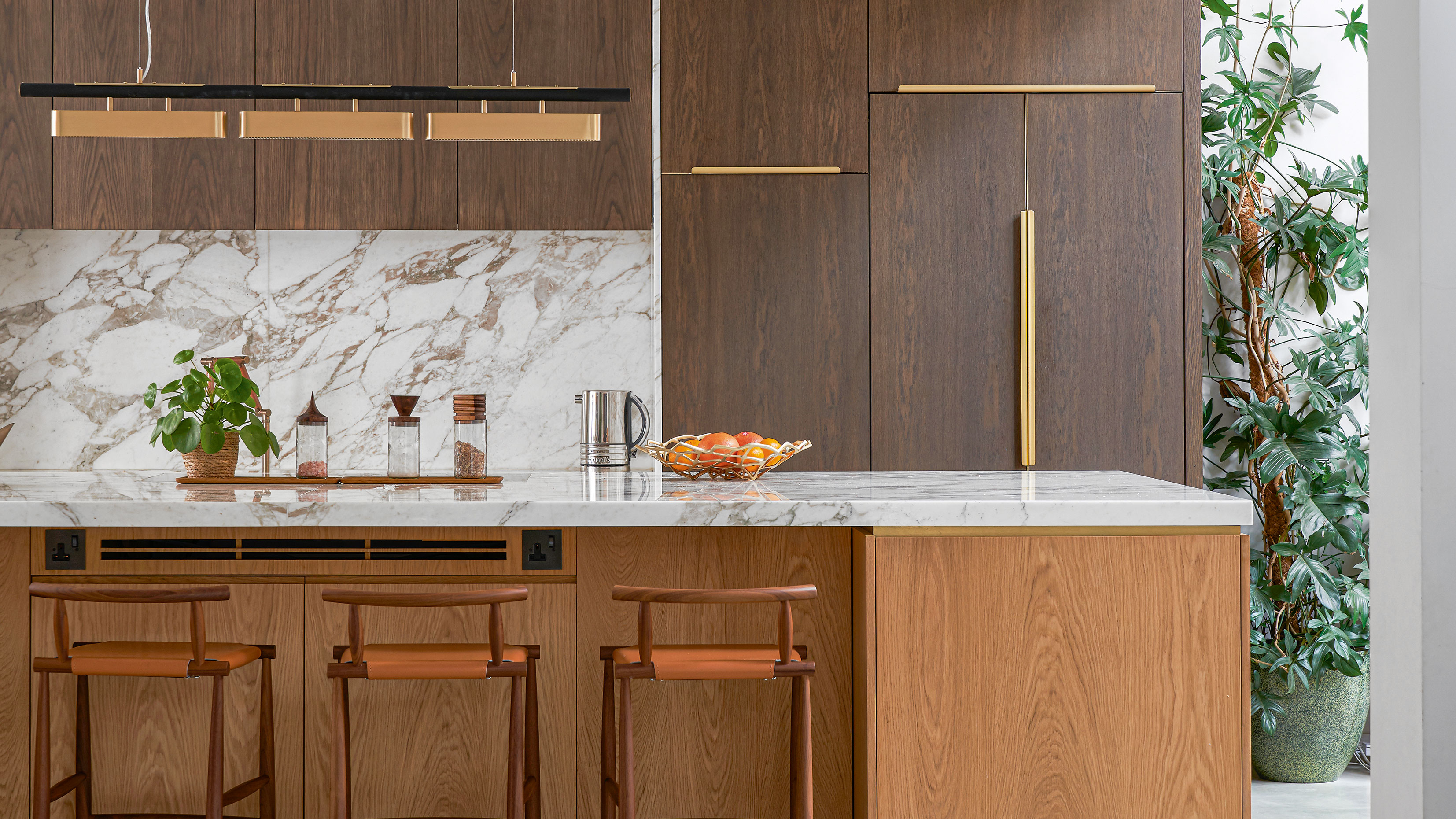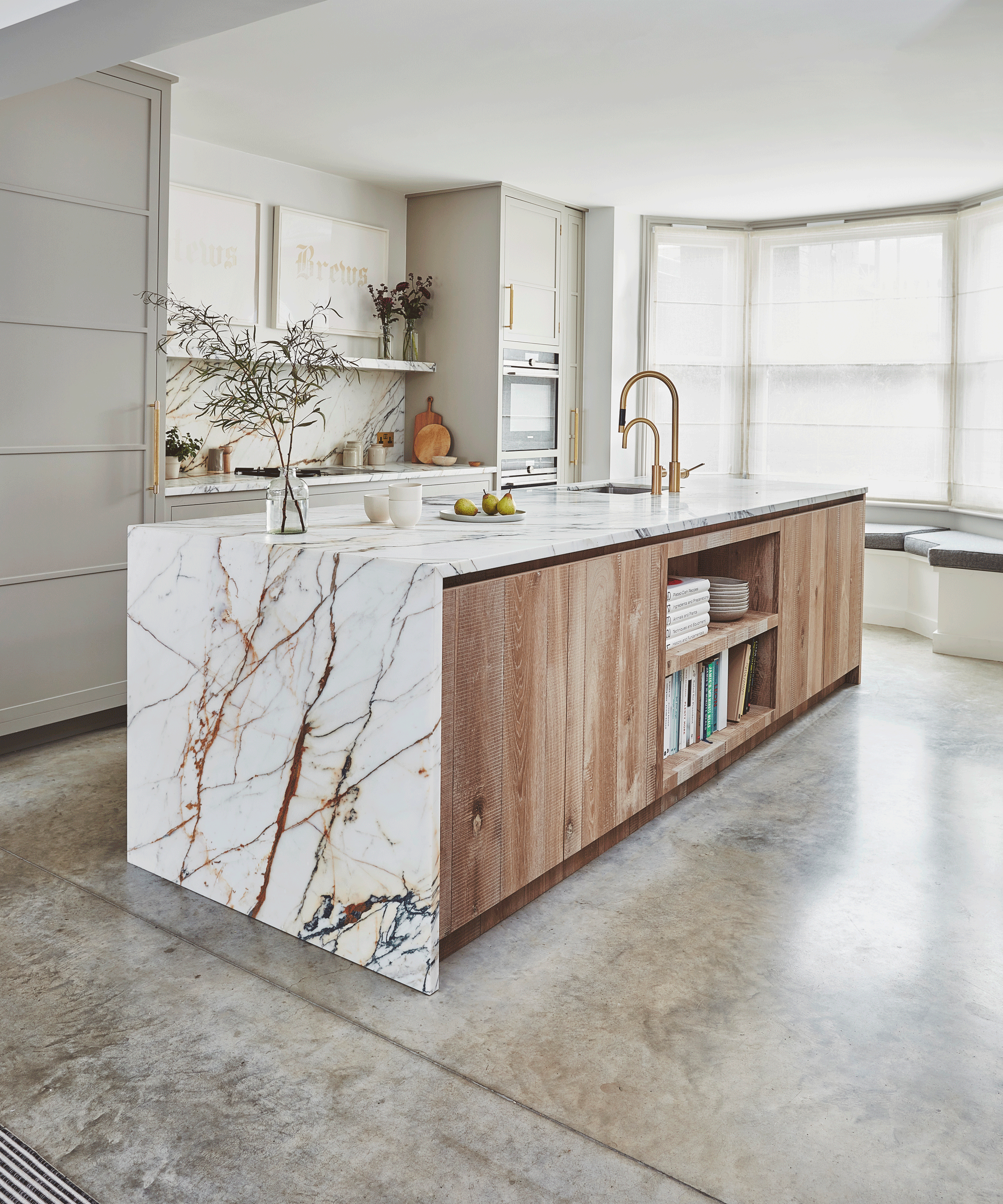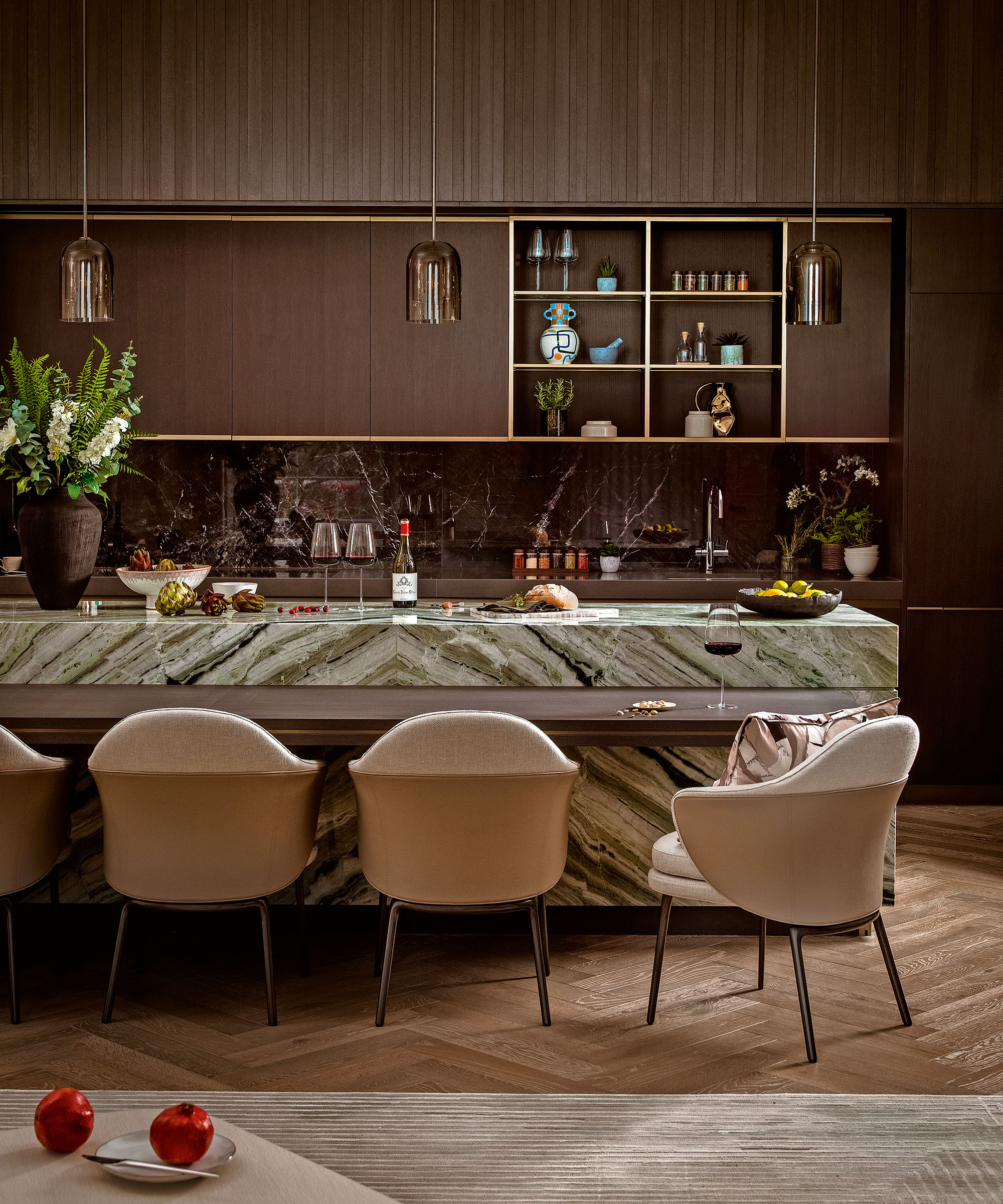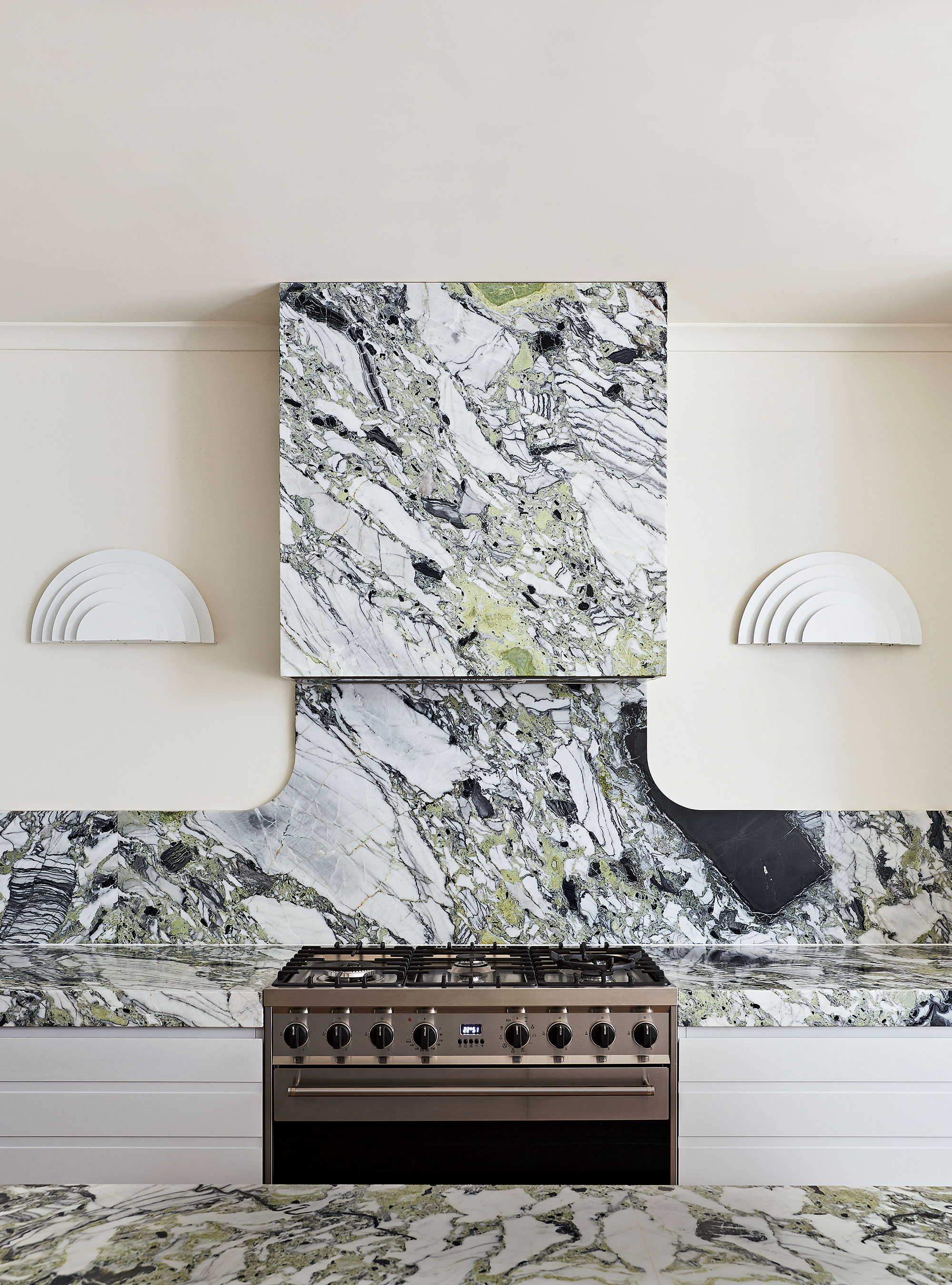Is marble bad for kitchens? 10 things no one tells you about using this porous stone
This enduring and classic material has won over many hearts, but is there a reason you shouldn't invest in marble? We weigh up the arguments for and against using marble in the kitchen


If you’re in the process of a kitchen remodel and are undecided about whether to opt for a marble surface or backsplash, then you might be wondering if marble is bad for kitchens. The simple answer is no, but there are some questions we must answer first, as marble is certainly not right for every home.
Marble in the kitchen is not new, after all, modern interpretations and refreshing schemes keep this metamorphic rock an enduring classic. However, despite its beauty and elegance, marble is certainly not without its flaws, and if you are going to invest in this popular – and expensive – material, then you'll want to know every pro and con first before you begin to curate your dream modern kitchen.
There are, indeed, some key considerations to know before you invest, such as durability, heat resistance, and how easy it is to clean, alongside other considerations such as cost and whey it looks like. In this quick guide, we break down the characteristics of using marble in home design, rating how they test across these key criteria.
What is marble?
Before we dissect the pros and cons, it is worth knowing exactly what marble is and how it is formed.
'Marble is in general an igneous rock, formed from the cooling of magma,' explains Oliver Webb, director of stone specialist Cullifords. 'The colors and features are created by different cooling speeds of the minerals within the molten rock.' Marble, like granite, is, therefore, a completely natural product.

Is marble bad for kitchens?
The short answer is no, marble is not bad for kitchens. In fact, marble is a popular modern material, and one beloved by some of the best kitchen designers. It is certainly not a budget option but the beauty of marble is that you can add it to your kitchen ideas in varying amounts and it can still have a big impact.
Marble is one of the most coveted materials around the world and renowned for its excellence and durability,’ says Mike Manders, managing director of Lusso Stone. It is, however, more porous than some other natural stones or their lookalike synthetic materials, so it is more likely to stain and scratch and require ongoing maintenance. Make marble your choice if you admire its natural qualities and enjoy its developing patina of age, as its look will evolve over time. ‘You are guaranteed timelessness and complete individuality, as every piece of marble benefits from being unique, displaying different markings subject to each block,’ adds Mike.
Design expertise in your inbox – from inspiring decorating ideas and beautiful celebrity homes to practical gardening advice and shopping round-ups.
Marble: the pros

1. It is durable enough to withstand scratching from light kitchen utensils
Marble is an extremely durable choice, making this porous material among the best kitchen countertop and kitchen backsplash choices you can find. However, while marble is strong, it is prone to chipping, while a man-made material, like quartz, is much less likely to do so.
2. If sealed properly, it can be kept bacteria free
Since marble is naturally porous, there's a misconception that bacteria is a problem. The fact is marble actually contains antibacterial properties that make the surface resistant to mold and bacteria. For added protection, use an antibacterial cleaner on a regular basis to maintain this resistance.
3. Has a distinctive appearance
For many, the deciding factor lies in the appearance of the surface, and marble certainly has its own unique look. Marble, for example, tends to offer a bolder surface design thanks to its natural qualities.
'With marble, each piece is unique in color and pattern as it is 100% naturally occurring,' explains Richard Davonport, managing director of Davonport. 'This can, however, be a disadvantage for large worksurfaces as you might require multiple pieces of marble joined together, which can impact the overall aesthetic.'
4. Marble is heat-resistant
While marble is heat-resistant to a certain level, precautions should still be taken to avoid any direct heat. Thankfully, marble is considered to be a lot more heat-resistant than many other surface materials. Placing a hot pan on marble is unlikely to cause any damage or weaken the worktop’s integrity whereas putting a hot pan over 482°F (250°C) directly on a quartz worktop may cause thermal shock, causing the polymers to break down and the surface to fracture.
5. Every slab is completely unique
Marble is a wonderful material if you want to curate a kitchen that is completely unique and distinctive in design, and while marble might be hard to match, it is not impossible. Bookmatching is a process where two slabs, cut from the same block, are joined together, creating a mirror image at the join, which can be an effective design feature.
Marble: the cons

1. Marble countertop edges and corners are prone to chipping
Looked after properly, marble can prove extremely practical and durable, says Guy Stansfeld, director of 23+GS/318. 'However, if chipped or scratched, marble is difficult to fix. A specialist may use cement, or epoxy glue, or they may even just sand down the chip or scratch. My advice is to treat any marble surface like a piece of luxury furniture; clean it regularly, wipe off any greasy substances before they have time to penetrate, and don't leave items that could damage the surface on it for long periods,' he says.
2. Marble can feel cold
Too much stone can feel cold and sterile – and marble is no exception. To counteract the harsh and sterile feeling that can come from being surrounded by masses of stone, mix mediums.
‘I like to mix marble with wooden paneling on walls to introduce warmth and deaden the echo of hard surfaces,’ says the founder of Fiona Barratt Interiors, Fiona Barratt-Campbell. 'The mix of materials helps break up the monotony of the stone.'
3. Needs regular sealing to avoid absorption
In action, marble is stain-resistant. However, marble can require sealing, according to Oliver Webb, director of stone specialist Cullifords. 'A good sealant will prevent the ingress of water, oils, and other liquids on all natural stone,' he says.
When it comes to everyday cleaning, the best course of action for marble is simply warm, soapy water. Avoid the use of anything abrasive and be wary of certain chemicals such as chlorine and alkaline-based products, as these may cause damage.
4. Marble contains natural imperfections
If you are a perfectionist who likes to know exactly what you are getting, then marble might not be the option for you. The natural veining found in marble isn't easy to determine, and each slab is entirely different. However, this natural beauty is actually what makes marble such an alluring and enticing material.
'I think when designing a kitchen if you can afford to install slabs of marble, I would choose that over tile any day,' says interior designer Cara Woodhouse. 'I love seeing the natural markings, veining, and colors that trickle through the stone.'
5. Marble is expensive
Pricewise, marble comes in different grades, which command different prices. You may also find that rarer, more decorative marbles cost more. Marble can start from as little as $150/m², but higher-end marble can cost from $500/m²+.
Bear in mind that you’ll need to factor in extra fabrication costs for this enduring stone, especially where you’re having drainer grooves, inset sinks, and upstands incorporated as kitchen surfaces.

Jennifer is the Digital Editor at Homes & Gardens, bringing years of interiors experience across the US and UK. She has worked with leading publications, blending expertise in PR, marketing, social media, commercial strategy, and e-commerce. Jennifer has covered every corner of the home – curating projects from top interior designers, sourcing celebrity properties, reviewing appliances, and delivering timely news. Now, she channels her digital skills into shaping the world’s leading interiors website.